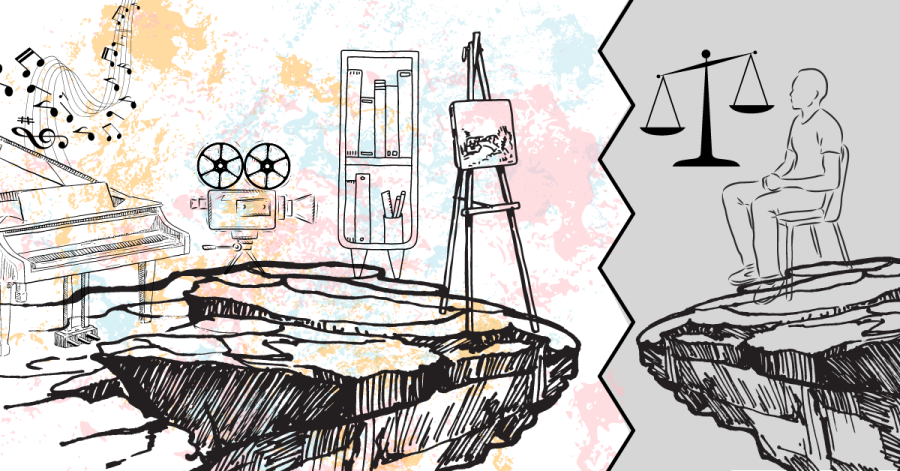Separating the art from the artist
The logic of analyzing academically influential art versus the ethics of supporting the morally dubious artist.
Separating the art from the artist has become a hot topic in the past year. Varying ideals about morality and knowledge have resulted in a grey area when deciding whether or not to support a work of art and it’s creator.
The history of art is full of controversy due to art’s inherent subjective nature; academics see value in analyzing problematic works, often regardless of why that piece is considered problematic. Recently, the strain on accepting controversy in the art world has increased as the contrary topics depicted in the works have taken a back seat to the immorality of the artists themselves. However, despite the misdeeds of the artists, many of the works attributed to them are still historically and culturally significant. With the rising discourse of opinions in the world, conversations have arisen about the morality of supporting an offensive artist for the benefit of their work.
The impact art has had on society as a whole is undeniable and even art of centuries past are still used as educational tools today. Censoring art because of its controversial nature has widely been condemned; Despite Christian displeasure, “Piss Christ,” a photograph by Andres Serrano depicting a crucifix submerged in a tank of urine, was exhibited in many well known galleries such as the Stux Gallery in New York City and the Southeastern Center for Contemporary Art in Winston-Salem, North Carolina in the 1980s and 90s. “Piss Christ” is a prime example of a time when the banning of art based on the controversial beliefs it displays was condemned. Censoring art due to its contentious nature has consistently been frowned upon, but people wonder if allowing censorship due to the contentious nature of the artist will simply lead to blind censorship of disagreeable works.
Furthermore, separation of the art and the artist allows for art to be analyzed educationally. The classic literature studied in English classes across the United States is often filled with controversial ideology. William Shakespeare’s “Merchant of Venice” makes many anti-Semetic assumptions and “The Taming of the Shrew” has been interpreted as quite misogynistic. Yet the academic value of Shakespeare’s work is undeniable; it sparks conversations about literary themes and societal situations of the time and so it continues to be taught.
Paintings such as “The Little Dancer Aged Fourteen” by Edgar Degas and “The Rape” by Pablo Picasso depict moments of extreme pain and violence which the models themselves were forced to undergo. Despite these problematic themes, these artworks are still exhibited in museums across the Western world because of their aesthetic appeal and influence on the art world. These pieces have been studied in academia for decades because regardless of the issues in the works, they still teach us about society and humanity. The beliefs and actions of the characters in the works are able to help us acknowledge and learn from their mistakes so that we don’t make them ourselves and negatively affect our world.
However, recently there has been a rise in condemnation of supporting art created by problematic artists. Famous rapper Ye West has lost much of his influence due to his anti-Semetic commentary and white-supremist ideas. R. Kelly has been shunned because he was revealed to be a pedophile and sexual abuser. Even the writer of the beloved “Harry Potter” series, J.K. Rowling has started to lose her fans because of her transphobic views and statements. Followers have found it to be impossible to enjoy works knowing the cruelty and discrimination perpetuated by the creators.
I think it would be improper to start banning works of art, especially since they can have such an educational benefit as seen by them being taught in our schools. Governments have been banning books for decades, yet people still read them. In times of genocide, art is the first thing to be burned; radios the first things to be corrupted. If society dictates an action immoral, it must be challenged by the people. But when should art be boycotted?
The line lies in the work’s effect on the world today. A piece of art that is used as a commentary on the issues in society, used to understand and learn, without any negative repercussions on real people, can only be beneficial. The problem arises when the work is used to manipulate and hurt in the real world.
Shakespeare’s “The Merchant of Venice” or “The Taming of the Shrew” are not funding corporations that push for the oppression of women. They are not being used to line the pockets of politicians working to legalize discrimination against Judaism. They are works that inspire people to recognize and fight against these horrible ideals in their own lives. Works like “Harry Potter,” however, never challenge the anti-Semetic tropes in the goblins or the acceptance of slavery in the house elves, instead encouraging readers to ignore these signs of oppression in real life. If none of the heroes of the story take action with these situations, why should the reader?
Kelly’s music directly talks about his abuse of women and sexual preferences toward teen girls. And because the creator is alive and shares the violent views perpetuated in the work, supporting these works of art funds their immoralities; Kelly was able to keep up with and hide a racketeering and sexual trafficking ring, and Rowling funds lawsuits against legislation that protects trans people and domestic violence support centers specifically designed to exclude trans women. West was able to fund his racist views by organizing a secret catwalk event at Paris Fashion Week where he debuted his line of ‘White Lives Matter’ t-shirts.
While there is significant value in all art, regardless of the topic or controversy surrounding that work, I think the real question to ask when deciding whether or not to indulge in or support a work of art is how that support will affect the real world and the real people the art is hurting.





